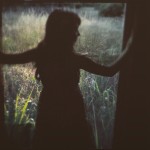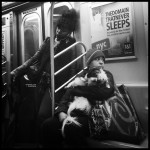Hey class last week we finished up the elements of design with perspective. The elements are key to building strong compositions and help us learn how to see. The #juxtschoolhouse tag had some really amazing examples.

I shot this photo for one of my favorite tags, #uptheladder, which was started by @nickdewald. I love perspective shots, and these kinds of ladders, typically mounted on the outside of grain silos or other storage devices, make for an unusual perspective. Fortunately for me, there are a lot of ladders like this in Minneapolis, where I live. I liked this one in particular, because it’s been well used over the years and so you can see how the metal bars have been bent over time. Those small imperfections in the symmetry make it more interesting to me.
To get this shot, I had to lie flat on my back (which always makes me like a shot more, because I feel like I had to work harder for it!). The edit was pretty straightforward. I knew I wanted to make it black and white, to emphasize the composition. I played around with brightness and contrast levels in Snapseed and Picfx to get the look I wanted, which was brighter in the middle (to emphasize the length of the ladder) and just enough detail in the blacks so you can make out what’s going on, but you’re not overwhelmed with too many details in the photo. I used Tune Image and Center focus in Snapseed, and a combination of Cross Process and some of the PFX filters in Picfx.
– Eric Mueller, @ericmueller
Photo by @rodanjosef
This shot was taken at favorite breakfast spot in Phinney Ridge. Inside, you’ll experience an warm eclectic feel, filled with vintage appliances and various textures. Fortunately, I was seated at the dining bar and was able to take a picture that fully captured my experience that day. I love the texture of the wall treatment – it was a heavily brushed steel that captured some of the sunlight from the outside. Some of my favorite pictures I’ve taken are of life urban landscapes that include stills of people from a distance. They become the nameless and faceless individual that I leave the viewer to focus on and hopefully identify with. The couple in this picture is a good example of this.
All right class, lets get going on our new topic which is one near and dear to my heart.
Monochromatic photography *sigh*
I have a long standing love affair with black and white photography. To me the images are timeless and stark. Removing the color forces the viewer to focus on the details instead of the color.When I first started shooting in Black and White, my photography teacher told me “you have to learn how to see in black and white.” He was a trial and error sort of teacher, meaning he let us find out on our own what would work and what wouldn’t. Learning that way was hard but rewarding, during critiques he would simply tell us to shoot it again if he didn’t like the results. Since my college days, I’ve seen the phrase “see in black and white” quite often so I thought I would take this class to explain how you go about seeing monochromatically.

Let’s go over a couple, okay more than a couple, terms. Just so I know we are on the same page.
Monochromatic:
Mono meaning one Chroma meaning hue/color. using one hue but different tonal values in a photograph.
another name for colors on the color wheel. Pure colors
Tone:
Adding gray to a color
Shade:
Adding black to a color
Tint:
Adding white to a color
Saturation:
color intensity. High saturation colors are bright while low saturation colors are dull.
Luminosity: is the lightness or the darkness of a color. Any color can be made lighter or darker.
Using monochromatic schemes you can use any single color plus tints, shades and tones. Within this type of scheme only the saturation and the luminosity of the color changes not the color itself. For example, if you decided to go with blue you would use an array of blue tones ranging from light to dark but you wouldn’t use shades of blue and shades of red. I realize it seems simple but I see images tagged monochromatic frequently that are no were near the ballpark.
What falls under monochromatic?
Black and White
Sepia falls under monochromatic because it is one color in varying shades. Did you know traditionally, sepia was made by bleaching a black and white photograph and then toning it to varying shades of sepia? Sepia can range from brown shades to almost orange. Sepia lends an old fashioned feel to a photograph.
Any other scheme that only contains one color with white, black, and grey added to create tonal values. (primary red, pink, dark red ETC)

The start of good monochromatic photograph is contrast. Those inky blacks, deep blues or browns and clean whites draw us in every time. But how can you know what is going to have good contrast once converted? The larger the range of color values from light to dark, the more contrast you will have once you convert your image to the monochromatic.
Next up is light, which can go hand in hand with contrast. You can key on light by using dramtic light or with tonal contrast of your subject. Take a look at Graham’s work. He plays on light quite often to highlight his subjects.
Another facet of monochromatic work is texture. Texture also links back to light and how it plays across your subject. If you move the light to shine across the subject it will pick up the texture.
There is no magic key to monochromatic photography. No set rules or compositions that work every time. Like everything, it takes practice. Many of our apps have options to convert to a wide range of color schemes. Snapseed is my favorite for the versatility of the tuning options. You have the option to desaturate then adjust the white balance to whatever shade you would like or you can go to the black and white option and use the color filters. Apps like filterstorm give you the added control of a curves feature or you can go the Hueless route and see what you are shooting in black and white while you’re shooting. Any way that you process, make sure your original image has texture, contrast, and the optimal light other wise you will end up with a flat lifeless image whatever color you choose.
Class dismissed!
About Author
Latest stories
 Featured ArticlesApril 13, 2015The Storytellers Vol. 4
Featured ArticlesApril 13, 2015The Storytellers Vol. 4 StoriesMarch 3, 2015Momdom
StoriesMarch 3, 2015Momdom Anna CoxFebruary 24, 2015Captain and the Kid
Anna CoxFebruary 24, 2015Captain and the Kid Anna CoxJanuary 19, 2015Honest Moments by Caleb Stumpfl
Anna CoxJanuary 19, 2015Honest Moments by Caleb Stumpfl


Thank you for this look at monochromatic photography. It’s my favorite style, especially for photomontage – artists like Jerry Uelsmann and Scott Mutter being prime examples. Contrast is the secret sauce, for sure.
A fantastic read with great practical examples of achieving impacting black and white photographs. Off to practice!